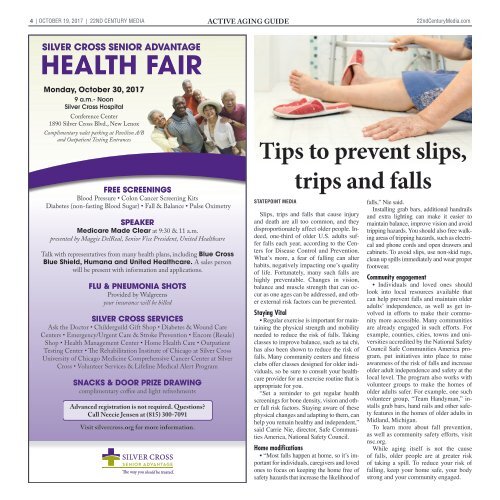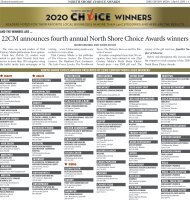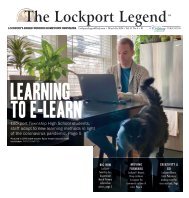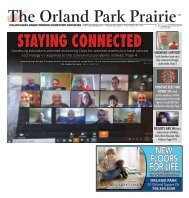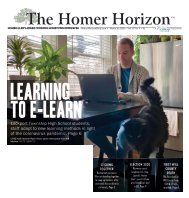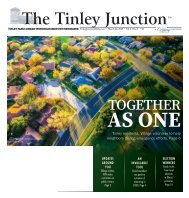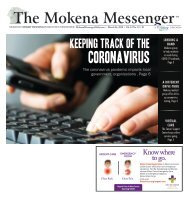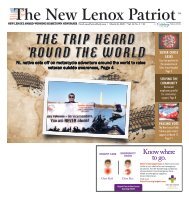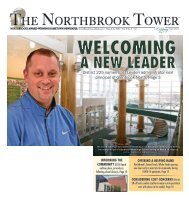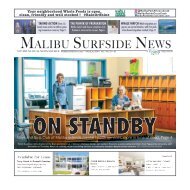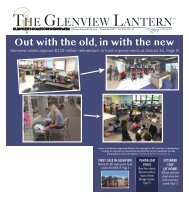Create successful ePaper yourself
Turn your PDF publications into a flip-book with our unique Google optimized e-Paper software.
4 | October 19, 2017 | 22nd century media active aging Guide<br />
22ndCenturyMedia.com<br />
SILVER CROSS SENIOR ADVANTAGE<br />
HEALTH FAIR<br />
Monday, October 30, 2017<br />
9 a.m.- Noon<br />
Silver Cross Hospital<br />
Conference Center<br />
1890 Silver Cross Blvd., New Lenox<br />
Complimentary valet parking at Pavilion A/B<br />
and Outpatient Testing Entrances<br />
FREE SCREENINGS<br />
Blood Pressure • Colon Cancer Screening Kits<br />
Diabetes (non-fasting Blood Sugar) • Fall & Balance • Pulse Oximetry<br />
SPEAKER<br />
Medicare Made Clear at 9:30 & 11 a.m.<br />
presented by Maggie DelReal, Senior Vice President, United Healthcare<br />
Talk with representatives from many health plans, including Blue Cross<br />
Blue Shield, Humana and United Healthcare. A sales person<br />
will be present with information and applications.<br />
FLU & PNEUMONIA SHOTS<br />
Provided by Walgreens<br />
your insurance will be billed<br />
SILVER CROSS SERVICES<br />
Ask the Doctor • Childerguild Gift Shop • Diabetes & Wound Care<br />
Centers • Emergency/Urgent Care & Stroke Prevention • Encore (Resale)<br />
Shop • Health Management Center • Home Health Care • Outpatient<br />
Testing Center • The Rehabilitation Institute of Chicago at Silver Cross<br />
University of Chicago Medicine Comprehensive Cancer Center at Silver<br />
Cross • Volunteer Services & Lifeline Medical Alert Program<br />
SNACKS & DOOR PRIZE DRAWING<br />
complimentary coffee and light refreshments<br />
Advanced registration is not required. Questions?<br />
Call Neecie Jensen at (815) 300-7091<br />
Visit silvercross.org for more information.<br />
Tips to prevent slips,<br />
STATEPOINT MEDIA<br />
trips and falls<br />
Slips, trips and falls that cause injury<br />
and death are all too common, and they<br />
disproportionately affect older people. Indeed,<br />
one-third of older U.S. adults suffer<br />
falls each year, according to the Centers<br />
for Disease Control and Prevention.<br />
What’s more, a fear of falling can alter<br />
habits, negatively impacting one’s quality<br />
of life. Fortunately, many such falls are<br />
highly preventable. Changes in vision,<br />
balance and muscle strength that can occur<br />
as one ages can be addressed, and other<br />
external risk factors can be prevented.<br />
Staying Vital<br />
• Regular exercise is important for maintaining<br />
the physical strength and mobility<br />
needed to reduce the risk of falls. Taking<br />
classes to improve balance, such as tai chi,<br />
has also been shown to reduce the risk of<br />
falls. Many community centers and fitness<br />
clubs offer classes designed for older individuals,<br />
so be sure to consult your healthcare<br />
provider for an exercise routine that is<br />
appropriate for you.<br />
“Set a reminder to get regular health<br />
screenings for bone density, vision and other<br />
fall risk factors. Staying aware of these<br />
physical changes and adapting to them, can<br />
help you remain healthy and independent,”<br />
said Carrie Nie, director, Safe Communities<br />
America, National Safety Council.<br />
Home modifications<br />
• “Most falls happen at home, so it’s important<br />
for individuals, caregivers and loved<br />
ones to focus on keeping the home free of<br />
safety hazards that increase the likelihood of<br />
falls,” Nie said.<br />
Installing grab bars, additional handrails<br />
and extra lighting can make it easier to<br />
maintain balance, improve vision and avoid<br />
tripping hazards. You should also free walking<br />
areas of tripping hazards, such as electrical<br />
and phone cords and open drawers and<br />
cabinets. To avoid slips, use non-skid rugs,<br />
clean up spills immediately and wear proper<br />
footwear.<br />
Community engagement<br />
• Individuals and loved ones should<br />
look into local resources available that<br />
can help prevent falls and maintain older<br />
adults’ independence, as well as get involved<br />
in efforts to make their community<br />
more accessible. Many communities<br />
are already engaged in such efforts. For<br />
example, counties, cities, towns and universities<br />
accredited by the National Safety<br />
Council Safe Communities America program,<br />
put initiatives into place to raise<br />
awareness of the risk of falls and increase<br />
older adult independence and safety at the<br />
local level. The program also works with<br />
volunteer groups to make the homes of<br />
older adults safer. For example, one such<br />
volunteer group, “Team Handyman,” installs<br />
grab bars, hand rails and other safety<br />
features in the homes of older adults in<br />
Midland, Michigan.<br />
To learn more about fall prevention,<br />
as well as community safety efforts, visit<br />
nsc.org.<br />
While aging itself is not the cause<br />
of falls, older people are at greater risk<br />
of taking a spill. To reduce your risk of<br />
falling, keep your home safe, your body<br />
strong and your community engaged.


